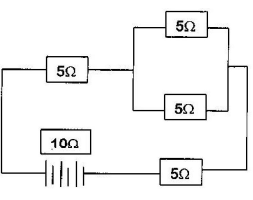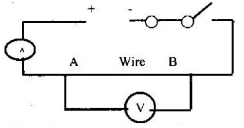Questions
- A student learnt that a battery of eight dry cells each 1.5v has a total e.m.f of 12V the same as a car battery. He connected in series eight new dry batteries to his car but found that they could not start the engine. Give a reason for this observation
-
- You are required to determine the resistance per unit length of a nichrome wire x, you are provided with A.D.C. power supply an ammeter and voltmeter.
- Draw a circuit diagram to show how you would connect the circuit.
- Describe how you would use the circuit in (a) (i) above to determine the resistance per unit length of x.
-
- State Ohm’s Law.
- A filament lamp and a thermostat are ohmic devices to a certain extent. Explain.
- Explain why moving coil meters are unstable for the use of alternating voltages.
- Four 5Ω resistors are connected to a 10V d. c. supply as shown in the diagram below.
Calculate;-- The effective resistance in the circuit.
- The current I following in the circuit.
- You are required to determine the resistance per unit length of a nichrome wire x, you are provided with A.D.C. power supply an ammeter and voltmeter.
- Study the circuit diagram. Determine the potential drop across the 3 resistor.
- State two conditions that are necessary for a conductor to obey Ohm’s law.
-
- State Ohm’s law.
- Describe with aid of a diagram and experiment to verify Ohm’s law
- Two resistors R1 and R2 are connected in series to a 10V battery. The current flowing then is 0.5A. When R1 only is connected to the battery the current flowing is 0.8A.
- Value of R2
- Current flowing when R1 and R2 are connected in parallel with the same batter.
- Recharging is one of the practices of maintenance of accumulators. State two measurements, which need to be taken to help you decide when an accumulator is due for charging.
- A current of 0.08A passes in circuit for 2.5 minutes. How much charge passes through a point in the circuit?
- An ammeter, a voltmeter and a bulb are connected in a circuit so as to measure the current flowing and the potential difference across both. Sketch a suitable circuit diagram for the arrangement.
-
- In the circuit diagram shown, calculate the effective resistance between Y and Z.
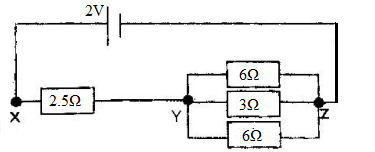
- Determine the current through the 3Ω resistor.
- One of the 6Ω resistors has a length of 1m and cross-sectional area of 5.0 x 10-5m2. Calculate the resistivity of the material.
- In the circuit diagram shown, calculate the effective resistance between Y and Z.
- In the circuit diagram five resistors are connected to a battery of e.m.f. 4V, and negligible internal resistance. Determine:
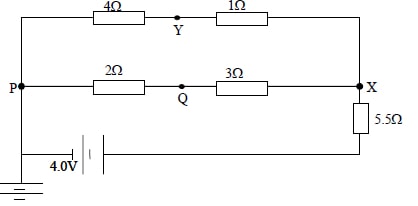
- The total resistance of the circuit.
- The current flowing through the 5.5Ω resistor.
- The potentials at points Y and Q.
- The potential difference between Y and Q
- An electric bulb with a filament of resistance 480Ω is connected to a 240V mains supply. Determine the energy dissipated in 2 minutes.
- A student wishes to investigate the relationship between current and voltage for a certain device X. In the space provide, draw a circuit diagram including two cells, rheostat, ammeter, voltmeter and the device X that would be suitable in obtaining the desired results.
- In the circuit diagram shown in the figure below, the ammeter has negligible resistance. When the switch S is closed, the ammeter reads 0.13A.
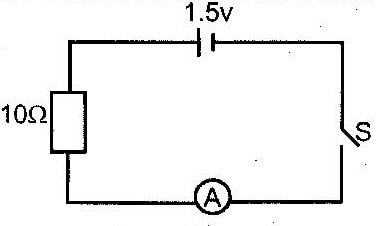
Determine the internal resistance of the cell. -
- State Ohm’s law.
- The graph in the figure below shows the current voltage characteristics of a device, X.

- State with a reason whether the device obeys Ohm’s laws.
- Determine the resistance of the device, X, when the current through it is 60m A.
- When the device, X, is connected in the circuit below, the voltage across it is 0.70V.
Calculate the value of the resistance R.
- The cell in the figure below has an emf of 2.1V and negligible internal resistance.
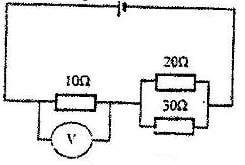
Determine the- Total resistance in the circuit.
- Current in the circuit
- Reading on the voltmeter
- State two advantages of an alkaline battery over a lead acid battery
- The diagram below shows an electrc circuit. When the switch is close the ammeter reading is 0.3A

Determine the voltmeter reading. -
- In the circuit diagram shown, calculate the effective resistance between Y and Z
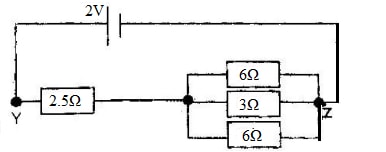
- Determine the current through the 3Ω resistor.
- In the circuit diagram shown, calculate the effective resistance between Y and Z
- A battery of e.m.f. 3v drives a current through a 20Ω resistor. The p.d across the resistor is 2.8v as measured by a voltmeter. Calculate the internal resistance of the battery.
- A torch uses two identical dry cells connected in series. When a bulb of resistance 2.0 ohm’s is connected across the cells the pd across the bulb is 2.0 v. When a bulb of resistance 1.5 ohms is used, the p.d is 1.8v, calculate the e.mf and internal resistance of each cell.
- Suppose a high–resistance voltmeter reads 1.5v connected across a dry battery on open circuit and 1.2v. when the same battery is in a closed circuit when it is supplying a current of 0.3A through a lamp of resistance R.
- Draw a circuit diagram to show the above experiment when in;
- Open circuit
- Closed circuit.
- What is
- The emf of the battery.
- The internal resistance of the battery
- The value of R?
- Draw a circuit diagram to show the above experiment when in;
- When a resistor is connected across the terminals of a battery a current of 0.20 A flows.
- What is the time taken for 2.0 coulombs of charge to pass a given point in the circuit?
- If e.m.f of the battery is 4.0v and its internal resistance is 0.20hm determine the rate at which heat is produced in the resistor.
-
- State Ohm’s law.
- In an experiment to determine the resistance of a resistor x, it is connected in parallel with a 100 Ω resistor. The current through the combination and the p.d across the combination is tabulated as shown below.
Draw a diagram of the circuit that could have been usedPotential difference (v) 1.5 3.0 4.5 6.0 7.5 Current (A) 0.075 0.015 0.225 0.30 0.375 -
- plot a graph of current against potential difference.
- Calculate the gradient of the slope
- Calculate the resistance of resistor x.
Answers
- Dry cells have a very high internal resistance hence give very little current that start a vehicle.
-
-
-
- - Measure length of wire (L)
- Take readings of ammeter (I) and voltmeter (V)
- Calculate its resistance R
- Then find the value R/L
-
-
- The current flowing through a resistor is directly proportional to the p.d. applied as long as the physical factors remain constant.
- If the temperature is controlled to remain constant then they obey ohm’s law. If temp is changed, they don’t obey.
- Every time the current is reversed the direction of key pointer also reversed. This would give an average of zero.
-
- For the two 3Ω resistors in parallel their total = product/sum=1.5 Ω
For series connection i.e. 3.3 and 1.5Ω, total 7.5 Ω
∴ RT = 7.5 Ω
-
I = E = 10v = 1.33A
RT 7.5
- For the two 3Ω resistors in parallel their total = product/sum=1.5 Ω
-
- RT = product/sum = 9 x 18= 4.5 Ω
I = 12/4.5 = 8/3 Amps
I through the 3 Ω is equal to I through the Ω since total resistance in each route are equal = 8/3 A x ½
p.d = 4/3 x 3 = 3V - Constant temperature, magnetic field, tension, compression, kinks etc.
-
- The current flowing through a resistor is directly proportional to the p.d applied as long as the physical constants are held constant.
-

- By varying R obtain a set of corresponding values for I and p.d readings
- Tabulate them
- Plot V against I
- If it is a straight line the law is obeyed, over wise not. -
- When R1 only is connected I = 0.8a
R1 = E/I = 10/0.8 = 12.5 Ω
When both are connected, then
(R1 + R2) 0.5 = 10
(R2 + 12.5) = 20
R2 = 7.5 Ω - When in parallel RT = products/sum = 4.6875 Ω
I= 10/4.6875 = 2.133A
- When R1 only is connected I = 0.8a
- - Rod of the acid
- Voltage emf of the battery
- Q= It = 0.08 x 2.5 x 60 = 12C
-
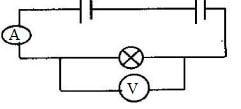
-
- 1/RT = 1/6 + 1/3 + 1/6 = 4/6 = 2/3
∴ RT = 1.5 Ω - For the whole circuit Rt = 1.5 + 2.5 = 4 Ω
Main current = E/RT = 2/4 = 0.5A
p.d across YZ = IR = 0.5 x 1.5 = 0.75V
p.d across any of the resistors in parallel
3 x I = 0.75A
I = 0.25 A
- 1/RT = 1/6 + 1/3 + 1/6 = 4/6 = 2/3
-
- For parallel connection RT = Products/ sum
= (5 x 5) = 2.5 Ω
(5 + 5)
∴ Total resistance = 2.5 + 5.5 = 8.0 Ω - Current= main current = R/RT = 4/8 = 0.5 Ω
- Note currents through Y and Q are equal since the resistance values are equal – through the two routes.
Let potential be rep. by P
Py – Pp = 0 (earthed)
∴ Py = IV
PQ = PP = P.dQP = 0.25 x 2 = 0.5V
PQ – 0= 0.5
PQ = 0.5V - PDYQ = Py – PQ = 0.5V
- For parallel connection RT = Products/ sum
- E= Pt = V2 x 2 x 60 = 240 x 240 x 120
R 480
= 14400J
= 14.4KJ -
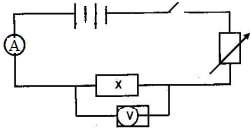
- I = 1.5
R + r
0.13 = 1.5
10 + r
R= 1.5Ω -
- The ratio of the pd across the ends of a metal conductor to the current passing through it is a constant.
-
- It does not obey Ohm’s law; because the current – voltage graph is not linear throughout
- Resistance = V/I = inverse of slope
(0.74 – 0.70)V
(80- 50)mA
= 0.40V
30 x 10-3 A
= 1.33 Ω - From the graph current flowing when pd is 0.70 is 60mA
Pd across R= 6.0 – 0.7 = 5.3V
R= 5.3V
60mA
= 88.3 Ω
-
- Parallel circuit 1/30 + 1/20 = 5/60
R= 12 Ω
Total resistance = 10 + 12 = 22 Ω - I = V/R = 2.1/22 = 0.095 A
- V= IR = 10 x 2.1
22
= 0.95V
- Parallel circuit 1/30 + 1/20 = 5/60
- - Alkaline cell last longer than lead acid cell
- Alkaline cell is more rugged than lead acid cell
- Alkaline cell is lighter than lead acid cell - 2V
-
- 4 Ω
- 0.5A
- 1.43 Ω
- 1.5v, 0.5 Ω
-
-
- 1.5 V,
- 1Ω
- 4 Ω
-
-
- 10s
- 0.792w
Join our whatsapp group for latest updates
Tap Here to Download for 50/-
Get on WhatsApp for 50/-
Download Current Electricity Questions and Answers - Physics Form 3 Topical Revision.
Tap Here to Download for 50/-
Get on WhatsApp for 50/-
Why download?
- ✔ To read offline at any time.
- ✔ To Print at your convenience
- ✔ Share Easily with Friends / Students

